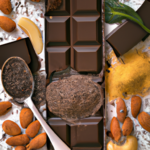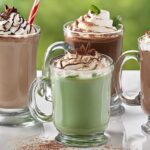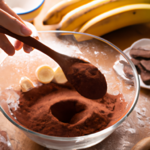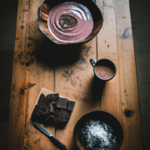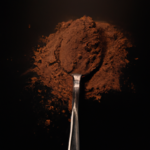Raw Food Ingredients
How Much Raw Cacao To Protein Shake
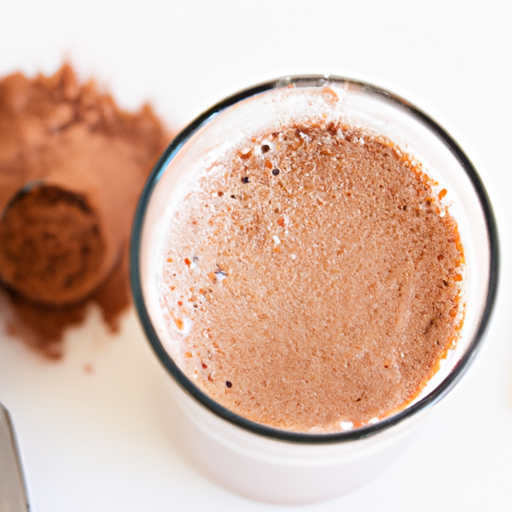
Adding raw cacao to your protein shake can boost the flavor and give you an energy kick. Raw cacao has a delicious taste and is packed with health benefits. Including raw cacao in your protein shakes can enhance your overall nutrition. It is important to figure out the right amount of raw cacao that suits your taste preferences and fitness objectives. Knowing the nutritional value of raw cacao and taking into account the protein content of your shake is crucial. By striking a balance between raw cacao and protein, you can indulge in a tasty and nutritious drink that powers your workouts and fulfills your cravings.
Key Takeaways
- Experiment with different amounts of raw cacao to find your preferred taste in a protein shake.
- Raw cacao provides an energy boost and enhances the flavor of protein shakes.
- Adjust your raw cacao intake based on your fitness goals and body’s response.
- Incorporate raw cacao into other meals, such as smoothie bowls or cacao chia pudding, for delicious and nutritious options.
Benefits of Adding Raw Cacao to Your Protein Shake
Adding raw cacao to your protein shake has numerous benefits. First, it enhances the flavor of your shake while providing a range of health benefits. Raw cacao is packed with antioxidants that combat free radicals and reduce inflammation in the body. Moreover, it is a great source of magnesium, iron, and fiber, which are crucial for overall health. By incorporating raw cacao into your daily routine, you can improve cardiovascular health, boost brain function, and enhance your mood. Additionally, the flavonoids in raw cacao have been found to possess anti-cancer properties. Understanding the health benefits of raw cacao is essential for making informed choices about your diet and lifestyle. Now, let’s explore the nutritional value of raw cacao.
Understanding the Nutritional Value of Raw Cacao
To fully understand the nutritional value of raw cacao, it’s important to consider its impact on protein intake and how it can enhance the taste and texture of your favorite drink. Raw cacao not only tastes great but also offers a range of nutrients that support overall health. Here are some key nutritional benefits of raw cacao:
-
Rich in antioxidants: Raw cacao contains high levels of antioxidants, which can reduce oxidative stress and protect your cells from damage.
-
Good source of minerals: Raw cacao is packed with essential minerals like magnesium, iron, and zinc, which play crucial roles in various bodily functions.
-
Boosts mood and energy: Raw cacao contains natural compounds that can increase serotonin and endorphin levels, leading to improved mood and an energy boost.
Incorporating raw cacao into your protein shake allows you to enjoy these nutritional benefits without compromising the taste and texture. Now, let’s move on to determining your personal taste preferences when it comes to adding raw cacao to your protein shake.
Determining Your Personal Taste Preferences
Determining your personal taste preferences can provide insight into how you can best incorporate the rich flavors of raw cacao into your favorite beverage.
Experimenting with different amounts of raw cacao in your protein shake is key to finding the right balance that suits your palate.
Some people prefer a more intense chocolate taste and may opt for a larger amount of cacao, while others may prefer a milder flavor and choose a smaller amount.
It’s all about finding what works best for you.
Start with a small amount and gradually increase it until you reach your desired level of chocolatey goodness.
This way, you can customize your protein shake to perfectly suit your personal preferences.
Start with a Small Amount and Gradually Increase
Start with a small amount of raw cacao in your protein shake. Gradually increase the amount to find your preferred taste. This allows your taste buds to adapt and appreciate the unique flavors of cacao. Experiment with different flavors and combinations to enhance your protein shake experience. There are endless possibilities for delicious and nutritious beverages.
Experiment with Different Flavors and Combinations
Get creative and mix up a variety of flavors and combinations to discover the perfect blend for your taste buds. Experimenting with different flavors is a fun and exciting way to enhance the taste of your protein shake. By adding ingredients like fruits, spices, or extracts, you can create unique and delicious flavor profiles. To help you get started, here’s a table with some flavor ideas:
| Flavor | Ingredients | Combination |
|---|---|---|
| Chocolate | Raw cacao, almond milk | Banana |
| Berry Blast | Mixed berries, yogurt | Spinach |
| Tropical | Pineapple, coconut milk | Mango |
| Coffee | Espresso, protein powder | Almond butter |
Remember, each person’s taste preferences are different, so don’t be afraid to experiment and find the perfect combination that suits you. Once you have mastered the flavors, it’s time to consider the protein content of your shake.
Consider the Protein Content of Your Shake
When it comes to your protein shake, it’s important to consider the amount of protein it contains to ensure you’re meeting your nutritional needs. Protein shakes have become popular for their numerous benefits, including muscle recovery, weight management, and increased satiety. If you’re looking to maximize the protein content of your shake, here are five key factors to consider:
- Choose a high-quality protein powder that contains a significant amount of protein per serving.
- Add Greek yogurt or cottage cheese to increase the protein content.
- Incorporate almond butter or chia seeds for an additional protein boost.
- Use milk or a milk alternative that is high in protein.
- Experiment with protein shake recipes that include ingredients like spinach, kale, or spirulina for added protein and nutrient density.
Adding raw cacao for an energy boost is a great way to enhance the flavor and nutritional profile of your protein shake.
Adding Raw Cacao for an Energy Boost
For an extra boost of energy in your shake, try adding raw cacao to really amp up the flavor and nutritional benefits. Raw cacao is a powerhouse ingredient that is packed with antioxidants, vitamins, and minerals. It is important to note that raw cacao and cocoa powder are not the same. Raw cacao is made by cold-pressing unroasted cocoa beans, which retains more of its natural nutrients compared to cocoa powder, which is processed at higher temperatures. Adding raw cacao to your protein shake not only enhances the taste but also provides a natural source of energy. Additionally, raw cacao can be incorporated into other recipes like smoothies, oatmeal, and baked goods for a healthy and delicious twist. Transitioning into the next section, adjusting the amount of raw cacao for your fitness goals is crucial to optimize your shake’s benefits.
Adjusting the Amount of Raw Cacao for Your Fitness Goals
To optimize your fitness goals, finding the perfect balance of raw cacao in your energizing shake is crucial. Adjusting your cacao intake can help you achieve the benefits of this superfood while aligning with your specific fitness objectives.
Incorporating cacao into your pre-workout routine can provide an energy boost and enhance your performance. Raw cacao contains natural compounds like flavanols, which improve exercise endurance and promote cardiovascular health.
However, moderation is key. Too much cacao can lead to unwanted side effects such as jitteriness or digestive issues. Start by adding a small amount of raw cacao to your protein shake and gradually increase the dosage based on your body’s response.
By adjusting your cacao intake, you can enjoy the delicious and nutritious results without overdoing it.
Enjoying the Delicious and Nutritious Results
After adjusting the amount of raw cacao in your protein shake to perfectly suit your fitness goals, you can now enjoy the delicious and nutritious results.
But why stop at just protein shakes? There are numerous ways to incorporate cacao into other meals and create mouthwatering dishes that are both satisfying and healthy.
From smoothie bowls to energy balls, the possibilities are endless. One of my favorite delicious cacao recipes is a cacao chia pudding.
Simply mix chia seeds, almond milk, raw cacao powder, and a natural sweetener of your choice, then let it sit in the fridge overnight. The next morning, you’ll have a rich and creamy pudding that will leave you satisfied and energized.
So go ahead, get creative in the kitchen and explore the world of cacao beyond your protein shake. Your taste buds will thank you.
Frequently Asked Questions
Can raw cacao be added to any type of protein shake?
Yes, raw cacao can be added to any type of protein shake. It not only enhances the flavor but also provides numerous benefits such as antioxidants and mood-boosting properties. To incorporate it properly, simply add a tablespoon to your shake and blend well.
Can raw cacao be substituted with other ingredients in a protein shake?
Yes, raw cacao can be substituted with other ingredients in a protein shake. Alternatives include cocoa powder, carob powder, or chocolate protein powder. However, raw cacao offers numerous benefits like antioxidants and mood-boosting effects.
Is there a maximum recommended amount of raw cacao to add to a protein shake?
The maximum recommended amount of raw cacao to add to a protein shake varies depending on personal preferences and tolerance. Raw cacao offers numerous benefits in protein shakes, such as antioxidants and natural mood-enhancing properties.
Can raw cacao affect the texture or consistency of a protein shake?
Raw cacao can definitely affect the texture and consistency of a protein shake, giving it a rich and creamy feel. Additionally, it adds a delicious chocolate flavor profile and provides nutritional benefits like antioxidants and minerals.
Are there any potential side effects of consuming too much raw cacao in a protein shake?
Consuming excessive amounts of raw cacao in a protein shake can lead to potential health risks. It is important to note that the recommended daily intake of raw cacao is around 20 grams to avoid any adverse effects.
How Much Raw Cacao Should I Add to My Protein Shake to Get Enough Protein?
When adding raw cacao to your protein shake, consider the protein content in raw cacao. For an adequate protein boost, add 2-3 tablespoons of raw cacao to get around 4-6 grams of protein. Adjust the amount based on your protein needs and desired flavor intensity.
Conclusion
In conclusion, adding raw cacao to your protein shake can be a delicious and nutritious way to enhance your fitness routine. By understanding the nutritional value of raw cacao and experimenting with different flavors and combinations, you can find the perfect balance for your personal taste preferences.
Whether you’re looking for an energy boost or trying to reach specific fitness goals, adjusting the amount of raw cacao in your shake is key. So go ahead, indulge in the rich and satisfying taste of raw cacao while reaping its numerous benefits.
Rachael, the Editor in Chief of RachaelsRawFood.com, is an inspiring and passionate individual who has dedicated her life to promoting the benefits of a raw food lifestyle. Known for her vibrant and energetic personality, Rachael has built a strong online presence that has transformed her personal journey into a thriving community of raw food enthusiasts.
Raw Food Ingredients
How Much Caffeine in Cocoa?
Not all cocoa products are created equal when it comes to caffeine content – discover which one might surprise you!

When evaluating the caffeine levels in cocoa, it’s important to recognize that dark chocolate contains around 43 mg of caffeine per 100 grams due to its high cocoa solid content. Dark chocolate has a higher caffeine content compared to milk or white chocolate. This means that consuming dark chocolate in moderation can assist in managing your caffeine intake. On the other hand, milk chocolate has around 20 mg of caffeine per 100 grams while white chocolate is caffeine-free. Cocoa powder, commonly used in baking and beverages, contains a substantial 230 mg of caffeine per 100 grams. Being aware of these distinctions in chocolates can help you make informed decisions about your caffeine consumption.
Key Takeaways
- Caffeine content in cocoa varies based on cocoa solid concentrations.
- Unsweetened cocoa powder can contain around 230 mg of caffeine per 100 grams.
- Roasting cocoa solids influences the final caffeine content in cocoa products.
- Dark chocolate, with high cocoa solid content, has more caffeine than milk chocolate.
- Moderate consumption of cocoa products helps manage caffeine intake.
Caffeine Content in Dark Chocolate
Dark chocolate boasts a caffeine content of approximately 43 mg per 100 grams, mainly deriving from its higher cocoa solid composition. When we indulge in this decadent treat, we aren't only savoring its rich cocoa flavor but also a subtle caffeine kick. Compared to milk or white chocolate, dark chocolate contains a higher amount of caffeine.
Please bear in mind that moderate consumption of dark chocolate can assist individuals in managing their caffeine intake effectively. The caffeine levels in dark chocolate are about one-fourth of what you'd find in a standard cup of coffee. So, if you're looking for a milder caffeine boost, a piece of dark chocolate might just do the trick without the jitters that sometimes accompany a strong cup of coffee.
Enjoy your dark chocolate in moderation, savoring both its taste and the gentle pick-me-up it provides.
Caffeine Levels in Milk Chocolate

Milk chocolate, known for its creamy texture and sweet flavor, contains a modest caffeine content of approximately 5.6 mg per ounce, as indicated by USDA data. Unlike dark chocolate, milk chocolate has a lighter color due to lower cocoa content, resulting in reduced caffeine levels.
The delightful creamy taste in milk chocolate comes from a harmonious blend of cocoa and milk powder. While dark chocolate boasts higher caffeine content, milk chocolate remains a popular choice for those seeking a sweet treat with minimal caffeine intake.
Caffeine Presence in White Chocolate
With its unique composition excluding cocoa solids, white chocolate stands out as a caffeine-free alternative to its darker counterparts. White chocolate is crafted from a blend of cocoa butter, milk powder, sugar, and vanilla, making it a delectable treat without the stimulating effects of caffeine. For individuals sensitive to caffeine, white chocolate offers a creamy texture and indulgent flavor without the worry of unwanted side effects. This makes it a popular choice for desserts among those looking to steer clear of caffeine in their sweet treats.
Compared to dark chocolate, which contains cocoa solids and hence caffeine, white chocolate provides a caffeine-free option for those seeking a more mellow indulgence. So, if you're in the mood for a luscious and smooth chocolate experience without the buzz of caffeine, white chocolate is the perfect choice for your next dessert delight.
Impact of Cocoa Solids on Caffeine

In determining the caffeine levels in cocoa products, the percentage of cocoa solids plays a significant role. Here are some key points about the impact of cocoa solids on caffeine content:
- Caffeine Derivation: The caffeine content in cocoa primarily comes from cocoa solids, making it an important factor in determining the overall caffeine levels in cocoa-based products.
- Dark Chocolate: Dark chocolate, known for its higher cocoa solid content, tends to contain more caffeine compared to milk or white chocolate varieties due to this higher concentration.
- Unsweetened Cocoa Powder: A 100g serving of unsweetened cocoa powder can contain around 230mg of caffeine, reflecting the impact of the high cocoa solid content in this form.
- Health Benefits: The roasting process of cocoa solids not only affects the flavor profile but also influences the caffeine content, contributing to the potential health benefits associated with consuming cocoa products like hot cocoa.
Comparing Caffeine in Different Chocolates
Comparing the caffeine content in different chocolates reveals varying levels based on their cocoa solid concentrations. Dark chocolate contains about 43 mg of caffeine per 100 grams, making it a stronger caffeinated option compared to milk chocolate, which only has around 20 mg per 100 grams.
Surprisingly, white chocolate, derived from cocoa butter, doesn't contain any caffeine at all. For those seeking a more potent caffeine kick, cocoa powder is the way to go, boasting a high concentration of 230 mg per 100 grams.
The amount of caffeine in chocolate products is closely linked to the cocoa solid content, with dark chocolate containing the highest levels. So, the next time you're craving a chocolate treat but also need a little energy boost, opt for dark chocolate to get the most caffeine per bite.
Frequently Asked Questions
Is There More Caffeine in Cocoa Than Coffee?
There's more caffeine in cocoa than in coffee. Cocoa powder packs 230 mg per 100 grams, surpassing most coffee varieties. Dark chocolate has even more caffeine due to higher cocoa content. It's a rich, unique energy source.
Is There a Lot of Caffeine in Hot Cocoa?
There isn't a lot of caffeine in hot cocoa. It depends on the brand and recipe. Starbucks hot chocolate has around 25 mg per serving, while basic mixes have about 5 mg. The amount of cocoa powder used influences the caffeine content.
Is There Caffeine in Hershey's Cocoa?
Absolutely, Hershey's Cocoa does contain caffeine, but it's not overwhelming. It adds a delightful hint of energy in each spoonful. Perfect for baking or a cozy cup of hot chocolate. Just the right amount!
Is Cocoa a Stimulant Like Caffeine?
Cocoa stimulates like caffeine due to its theobromine content. Decaf versions offer a solution for caffeine-sensitive folks. Options include regular cocoa with caffeine, Dutch-processed cocoa with less, and decaf cocoa with reduced caffeine while keeping healthful compounds.
What are the potential health effects of consuming high levels of caffeine in cocoa?
Unveiling cocoa caffeine levels can lead to potential health effects of excessive consumption. High levels of caffeine in cocoa may contribute to insomnia, nervousness, and fast heartbeat. It can also cause gastrointestinal discomfort and exacerbate anxiety disorders. Moderation in consuming caffeinated cocoa products is recommended for overall health.
Conclusion
To sum up, the caffeine content in cocoa varies depending on the type of chocolate. Dark chocolate typically has the highest caffeine levels, followed by milk chocolate and white chocolate. The amount of cocoa solids in the chocolate also affects the caffeine content.
Remember, just like different chocolates have different levels of caffeine, we all have unique strengths and abilities. Embrace your individuality and always aim for balance in everything you do.
Rachael, the Editor in Chief of RachaelsRawFood.com, is an inspiring and passionate individual who has dedicated her life to promoting the benefits of a raw food lifestyle. Known for her vibrant and energetic personality, Rachael has built a strong online presence that has transformed her personal journey into a thriving community of raw food enthusiasts.
Raw Food Ingredients
5 Key Differences: Caffeine Content in Cocoa Vs Coffee
Open the door to understanding the contrasting caffeine levels in cocoa and coffee, revealing surprising insights that will reshape your beverage choices.

When comparing the caffeine levels in cocoa and coffee, it is important to understand that cocoa generally has lower caffeine content than coffee. Dark chocolate contains approximately 12 milligrams of caffeine per ounce, while hot cocoa typically ranges from 5 to 10 milligrams per ounce. In contrast, brewed coffee can have significantly higher levels, varying from 95 to 165 milligrams per 8-ounce cup.
Cocoa is considered a milder option for individuals aiming to limit their caffeine intake, with theobromine providing a gradual energy increase. Meanwhile, coffee's caffeine content offers immediate alertness, and understanding these distinctions can help you select based on your preferred effects.
Key Takeaways
- Cocoa contains lower caffeine levels but compensates with theobromine for a gradual energy increase.
- Coffee has higher caffeine content, offering an immediate alertness boost and potentially higher metabolic rate.
- Theobromine in cocoa promotes relaxation, while caffeine in coffee provides intense alertness and mood fluctuations.
- Hot chocolate is a good option for reducing caffeine intake while still benefiting from theobromine effects.
- Understanding caffeine variances helps make informed choices for desired energy levels and mood effects.
Caffeine Levels in Cocoa Vs Coffee
When comparing caffeine levels in cocoa versus coffee, it's evident that cocoa generally contains lower amounts per serving. Dark chocolate, made from cacao beans, contains around 12 milligrams of caffeine per ounce, while a 1-ounce serving of hot cocoa mix typically has 5-10 milligrams. Even a 16-ounce serving of Starbucks hot chocolate only contains about 25 milligrams of caffeine.
On the other hand, coffee, when brewed, can range from 95 to 165 milligrams of caffeine per 8-ounce cup, depending on the type and brewing method. This significant difference in caffeine content between cocoa and coffee makes cocoa a milder option for those looking to limit their caffeine intake.
Impact on Alertness and Energy

Typically, the immediate alertness and energy boost from caffeine in coffee can last for hours. This surge in alertness is due to caffeine's stimulating effect on the central nervous system. On the other hand, cocoa contains theobromine, which provides a more gradual increase in energy levels. Unlike caffeine, theobromine doesn't cause sudden spikes and crashes, offering a smoother energy curve.
Coffee's caffeine content can temporarily boost the metabolic rate, potentially supporting weight management efforts. This increased metabolic rate can aid in burning calories and may contribute to weight loss when combined with a balanced diet and regular exercise. Additionally, theobromine in cocoa contributes to the thermogenic effect, leading to mild calorie burning in the body.
Both caffeine and theobromine can influence mood. Caffeine tends to provide a more intense and quick-acting mood elevation, while theobromine promotes feelings of relaxation and contentment. Understanding the differences in alertness, energy, metabolic effects, and mood enhancements between cocoa and coffee can help individuals make informed choices based on their preferences and wellness goals.
Metabolic Variances and Effects
Regarding metabolic variances and effects, the varying caffeine levels between cocoa and coffee play a significant role. When comparing the metabolic impact of caffeine in cocoa and coffee, it is crucial to note that cocoa contains lower levels of caffeine but compensates with theobromine, which aids in the thermogenic effect, promoting calorie burning and metabolic activity. On the other hand, coffee, especially brewed varieties, contains higher levels of caffeine, potentially providing a temporary boost to the metabolic rate, which could assist in weight management. While caffeine in coffee offers a quick energy surge, theobromine in cocoa leads to a more gradual rise in energy levels, avoiding sudden spikes and crashes. To summarize the metabolic differences, I've created a table below:
| Aspect | Cocoa | Coffee |
|---|---|---|
| Caffeine Content | Lower levels | Higher levels |
| Additional Component | Theobromine | Caffeine |
| Metabolic Impact | Thermogenic effect | Temporary metabolic rate boost |
| Energy Levels | Gradual rise | Quick surge |
| Weight Management | Aids in calorie burning | Potential assistance |
Mood Enhancement Disparities

In comparing the mood enhancement effects of theobromine in cocoa and caffeine in coffee, notable disparities emerge in their impact on mental well-being.
The theobromine found in cocoa promotes relaxation and contentment, offering a gradual rise in energy levels that leads to a gentle and long-lasting mood enhancement experience.
On the other hand, caffeine delivers an intense and fast-acting boost in alertness, providing immediate energy levels that can lead to abrupt spikes and crashes.
While both theobromine and caffeine uplift mood, theobromine's effects are characterized by a steady and gradual increase in energy levels, creating a sense of calm and contentment.
In contrast, caffeine's impact is more intense and temporary, resulting in rapid alertness but also the potential for fluctuations in mood. Understanding these differences can help individuals choose between cocoa and coffee based on their desired mood enhancement effects.
Health Implications and Considerations
Health implications and considerations surrounding caffeine consumption warrant close attention due to its potential impact on various aspects of well-being. When comparing a cup of coffee to hot chocolate, it's vital to note the amount of caffeine present.
While coffee contains much caffeine, hot chocolate has less caffeine but isn't entirely devoid of it. The main active ingredients in hot chocolate are theobromine and caffeine, where theobromine is a relative of caffeine and also has stimulant effects, although milder. If you're looking to reduce your caffeine intake, opting for hot chocolate over a cup of coffee can be a good choice.
Being mindful of the caffeine content in chocolate products is important, especially if you're sensitive to caffeine or belong to vulnerable populations like children or pregnant women. Understanding the caffeine levels in different beverages allows you to make informed decisions about your consumption for better overall health.
Frequently Asked Questions
Is There Caffeine in Coffee Vs Cacao Powder?
Yes, there is caffeine in coffee, with around 140 milligrams in a 12-ounce cup. On the other hand, cacao powder contains only about 12 milligrams per tablespoon, making it a great caffeine-free alternative for those seeking a milder boost.
What Is the Difference Between Cocoa and Coffee?
When comparing cocoa and coffee, cocoa offers a rich, chocolatey flavor and is packed with antioxidants and minerals. Coffee, on the other hand, provides a robust, bitter taste and a jolt of caffeine for that morning pick-me-up.
Why Is Cocoa Better Than Coffee?
I believe cocoa is superior to coffee because it offers a gentler energy boost, promotes relaxation and contentment, and provides sustained vitality without sudden crashes. Plus, dark chocolate's theobromine supports cellular health and tastes delicious.
How Much Caffeine Is in Cocoa Powder Vs Decaf Coffee?
In cocoa powder vs decaf coffee, cocoa has 12-26mg of caffeine per tbsp, while decaf coffee holds 2-5mg per 8-ounce cup. The choice hinges on desired caffeine levels and flavor. I prefer cocoa's lower caffeine content.
How does the caffeine content in hot chocolate compare to coffee?
Hot chocolate caffeine content is significantly lower than that of coffee. While an 8-ounce cup of hot chocolate contains about 5-10 milligrams of caffeine, the same size of coffee can have anywhere from 95-200 milligrams. It’s a notable difference for those looking to limit their caffeine intake.
Conclusion
To sum up, while cocoa and coffee both contain caffeine, the levels vary significantly. Cocoa generally has lower caffeine content compared to coffee, impacting alertness, energy levels, and mood enhancement differently.
It's crucial to keep these differences in mind when choosing between the two beverages for your daily consumption. Remember, moderation is key to maintaining a healthy balance in your caffeine intake.
So, whether you prefer a cup of cocoa or a mug of coffee, enjoy it in moderation for the best benefits!
Rachael, the Editor in Chief of RachaelsRawFood.com, is an inspiring and passionate individual who has dedicated her life to promoting the benefits of a raw food lifestyle. Known for her vibrant and energetic personality, Rachael has built a strong online presence that has transformed her personal journey into a thriving community of raw food enthusiasts.
Raw Food Ingredients
A Guide to Becoming a Good King
Kingship demands wisdom, fairness, integrity, courage, and humility – essential traits for a successful reign and prosperous kingdom." Keep reading to uncover the secrets of becoming a good king.

In order to be a good king, one must embody wisdom, fairness, integrity, courage, and humility to lead the kingdom with honor. Wisdom is essential for making important decisions, fairness ensures just treatment for all, integrity builds trust and respect, courage is crucial for facing challenges, and humility reminds us of our humanity. Historical kings such as Solomon, Arthur, David, Charlemagne, and Ramses II serve as role models for these leadership traits.
As a king, embracing challenges, understanding the world, seeking personal growth, and learning from the past are essential responsibilities. Developing leadership skills, making wise decisions, and prioritizing the well-being of the people are key to effective kingship. Every step on the path to becoming a good king is critical for a successful reign and prosperous kingdom.
Key Takeaways
- Embrace wisdom for informed decisions.
- Practice fairness for just treatment.
- Uphold integrity to earn trust.
- Show courage in facing challenges.
- Maintain humility for empathy and respect.
Qualities of a Good King
Being a good king requires embodying qualities such as wisdom, fairness, integrity, courage, humility, and compassion in decision-making and leadership. Power comes with responsibility, and as a king, it's essential to wield this power wisely. Wisdom is vital in making sound judgments that benefit the kingdom as a whole. Fairness guarantees that all subjects are treated justly and equitably, fostering a harmonious society. Integrity is the foundation of trust and respect, key elements in effective leadership.
Courage is necessary to face challenges and make difficult decisions, even when met with opposition. Humility reminds a king of his humanity and the importance of humility in interactions with all subjects. Compassion demonstrates a king's care and empathy towards his people, fostering a sense of unity and loyalty. Effective communication is crucial for conveying decisions, listening to concerns, and inspiring confidence in leadership.
Historical Kings as Role Models

King Solomon, renowned for his wisdom and leadership, stands as an exemplar among historical kings who serve as role models for future leaders. Looking at figures like King Arthur, known for his justice and valor in medieval legends, and King David, celebrated for his faith and courage in battle, we find lessons that transcend time. Charlemagne's legacy of military conquests and cultural revival, alongside Ramses II's grand building projects and military campaigns, offer diverse insights into effective kingship. Below is a table summarizing key attributes of these historical kings:
| King | Attributes |
|---|---|
| King Solomon | Wisdom, leadership |
| King Arthur | Justice, valor |
| King David | Faith, courage |
| Charlemagne | Military prowess, culture revival |
| Ramses II | Building projects, military campaigns |
Studying these historical figures can provide valuable lessons on the multifaceted qualities that make a great ruler.
Responsibilities of Kingship
Embracing challenges and living authentically are central to fulfilling the responsibilities inherent in kingship. As men aspiring to be good kings, it's essential for us to understand that the world requires leaders who are kind, humble, and committed to personal growth.
The journey to becoming a good king involves more than just wielding power and responsibility—it entails sacrificing comfort for growth and transformation. Seeking the ancient path of masculinity, as exemplified by figures like Morgan, teaches us the importance of humility, vulnerability, and character development.
In fulfilling the responsibilities of kingship, we're entrusted with power not for our own gain, but for the betterment of the world around us. Just as seeds need Good Soil to flourish, we must nurture our own growth to lead effectively.
Leadership Skills for Kings

Developing essential leadership skills is crucial for aspiring kings seeking to fulfill their responsibilities with humility, vulnerability, and a focus on character development. As you study the world around us, the power and responsibility of what kingship entails become clearer. Here are some key points to think about on your path to becoming a king:
- Embrace challenges and live authentically.
- Seek ancient paths of masculinity for guidance.
- Reflect on your identity, purpose, and ability to be entrusted with power for good.
- Sacrifice comfort for growth, transformation, and participation in universal creativity.
The journey of becoming a king isn't just about gaining authority but about understanding the remarkable fellowship of like-hearted individuals who share similar goals. Engage in group discussion questions, consider between-session personal study, and explore the depths of your masculine soul. This is the path to restoring what it means to be a true king.
Importance of Wise Decision-Making
Steering through the intricacies of leadership, especially in the domain of kingship, requires a sharp focus on the art of prudent decision-making. Wise decision-making is like the compass guiding the ship of leadership towards success.
Good kings understand that their choices impact not just themselves but also the lives of those they rule over. They prioritize the well-being of their people over personal gains, embodying the essence of true leadership.
Seeking counsel from trusted advisors and reflecting on core values are essential practices in the domain of wise decision-making. By embracing humility and self-awareness, kings can navigate the complex web of choices with clarity and integrity.
Just like a six-session video Bible study can guide individuals in restoring the heart, wise decision-making is essential for becoming the kind of leaders our world needs. Let's start on this journey of radical reconstruction, where every decision is a step towards being counted among the good kings of history.
Frequently Asked Questions
What Is the Becoming a King Guide?
The Becoming a King guide is a transformative resource created by Morgan Snyder to help men grow into responsible kings. It offers practical tools and profound insights to aid personal development and transformation.
What Are the Qualities of a Good King?
Being a good king means embodying humility, wisdom, and integrity. Prioritizing the well-being of my people, making decisions for the greater good, and showing courage, justice, and compassion in all actions. Seeking counsel and valuing diverse perspectives is essential.
What Makes a True King?
Beneath the crown lies a heart that beats with humility and a spirit that soars with honor. True kings are forged in the fires of challenge, embracing authenticity and growth to inspire others.
What Makes a Real King?
Being a true king means embodying humility, courage, and empathy. It's about serving others and leading with integrity. I endeavor to cultivate these qualities daily, embracing challenges and seeking growth in all aspects of my life.
How Can Sacred Cacao be Incorporated Into Kingship Rituals?
In kingship rituals, the sacred cacao ritual holds great significance. The ceremonial drinking of cacao symbolizes the divine connection between the ruler and the spiritual realm. It is believed to impart wisdom and strength, making it a crucial element in the coronation and leadership rites of many cultures.
Conclusion
To sum up, becoming a good king requires a combination of qualities, skills, and responsibilities. Remember, 'With great power comes great responsibility.'
By studying historical kings as role models, practicing leadership skills, and making wise decisions, one can aspire to be a just and effective ruler.
It's a challenging path, but with dedication and perseverance, anyone can endeavor to be a worthy leader for their kingdom.
Rachael, the Editor in Chief of RachaelsRawFood.com, is an inspiring and passionate individual who has dedicated her life to promoting the benefits of a raw food lifestyle. Known for her vibrant and energetic personality, Rachael has built a strong online presence that has transformed her personal journey into a thriving community of raw food enthusiasts.
-

 Raw Food Ingredients2 months ago
Raw Food Ingredients2 months agoHow To Make Hot Chocolate With Raw Cacao Powder
-

 Raw Food Ingredients2 months ago
Raw Food Ingredients2 months agoHow To Make Chocolate From Raw Cacao
-

 What is Raw Food?2 weeks ago
What is Raw Food?2 weeks agoHow To Remove Raw Mustard Oil Smell From Cooked Food
-

 Raw Food Ingredients4 weeks ago
Raw Food Ingredients4 weeks agoRaw Cacao Powder How Much For 8 Oz Hot Chocolate Recipe
-

 Raw Food Ingredients4 weeks ago
Raw Food Ingredients4 weeks agoThe Truth Behind the Cacao Caffeine Myth
-

 Raw Food Ingredients2 months ago
Raw Food Ingredients2 months agoWhen Fasting Can I Drink Coffee With Raw Cacao Powder
-

 What is Raw Food?2 weeks ago
What is Raw Food?2 weeks agoHow To Store Raw And Cooked Food Separately
-

 Raw Food Ingredients2 months ago
Raw Food Ingredients2 months agoHow To Use Raw Cacao Beans




